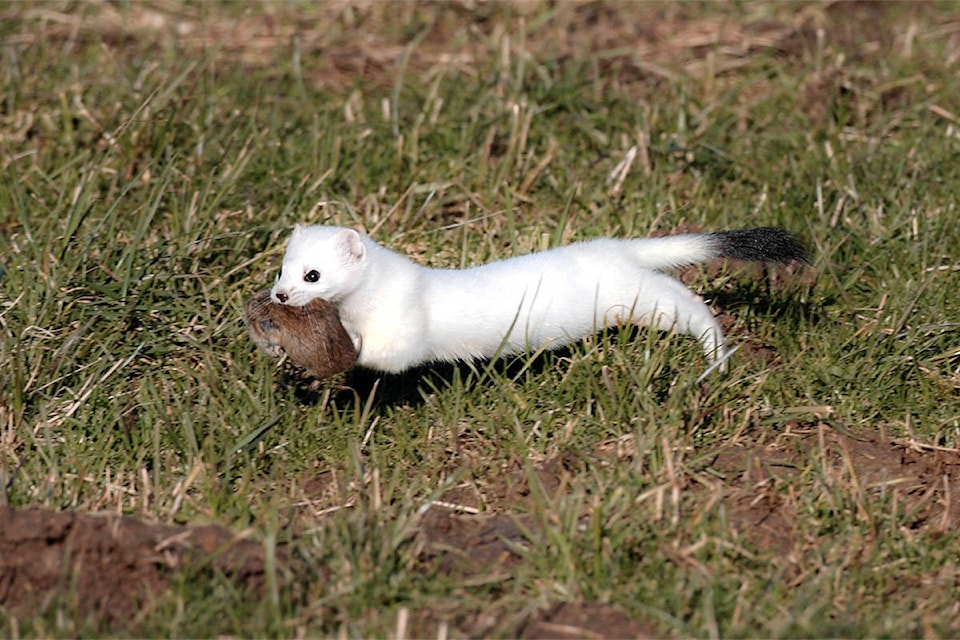With their downy-soft coats, oversized ears and cartoonishly-long whiskers, it would be easy to mistake an ermine for a frolicking woodland creature straight out of Bambi, but don’t underestimate them — ermines are stone-cold killers, albeit pocket-sized ones.
Weighing in at around 200 grams and maxing out at 30 centimetres in length for an adult male – about the same size as a red squirrel — ermines (Mustela erminea) are mustelids — members of the weasel family. This wide-ranging group includes martins, ferrets, otters and a more famous Yukon member, the wolverine, says Environment Yukon biologist Tom Jung, to which ermine themselves are related.
Ermines display sexual dimorphism — a significant difference in size between the sexes in a species — with males much larger than females, another oft-seen trait among mustelids.
Ermines are common in the Yukon and, although there are no estimates available on their exact numbers in the territory, their population is considered healthy and stable. They share Yukon’s forests with their close relative, the least weasel (Mustela nivalis), Jung says, and the two species are often mistaken for each other. Least weasels are about half the size of ermine, however — 25 cm long and maxing out at around 90 g — with the biggest least weasel about the same size as a small ermine.
A sure way to tell which animal you are dealing with, Jung says, is to look at the tail — ermines have a distinctive black tail, which is absent in the least weasel.
Both least weasels and ermines are examples of more “primal” mustelids, meaning that they look and behave more closely to what biologists believe the original ancestor of that family would have, as opposed to wolverine or otters, both of which have evolved more specialized behaviours, Jung notes.
Yukoners are most likely to spot ermines in the autumn and winter, Jung says, when the feisty predators seek out a sheltered place to hunt their favourite prey — voles and mice — in woodpiles and under sheds and porches.
As anyone who has ever had a ferret knows, holding a weasel feels not unlike trying to keep hold of a furry, living slinky, and ermines share this long, lean, highly flexible physique. This body plan is the little hunter’s “greatest advantage and, at the same time, greatest disadvantage,” says Jung, allowing them to creep swiftly up trees to go after birds and their eggs or wriggle down burrows like a snake to chomp on mice and voles.
This same slender build, however, means that ermines have a hard time putting on fat — a chubby ermine can’t get down a hole as quickly as a skinny one, after all — which means the animals have to hunt and eat more often, “constantly stoking the fire” of their rapid metabolism, Jung says.
As a result of their low body fat and high metabolic need, ermines do not hibernate and are instead active all winter, a season in which they must hunt even more voraciously, as staying warm during this bitter time takes even more calories than the summer months.
Ermines “live a tight existence” with “few reserves” and little room for error, he says, living “on the razor’s edge just to survive.”
In order to compensate for this live-fast-die-hungry lifestyle, female ermine employ a unique mustelid trick, one also shared with wolverines, reproducing only when their bodies can meet a “fitness threshold,” says Jung.
Mating occurs in the late spring or early summer, from March to July, but inception — actual impregnation — doesn’t occur until later. Females — called jills — store semen received from males — called jacks or hobs — until they are ready to use it in the colder months. If, when that time rolls around, a female ermine finds herself in an disadvantageous position — sick, hurt, underweight or otherwise unhealthy — she simply doesn’t get pregnant, skipping a breeding season in the hopes of being fitter and better able to produce healthy offspring next time around.
If a jill is healthy, however, the impregnation goes forward, and she will have a litter of kits in the spring, which will be born blind, naked and toothless but mature rapidly. Females nurse their young for only 12 short weeks — males have nothing at all to do with caring for their offspring — after which time the kits are on their own.
This short rearing period makes good evolutionary sense, says Jung, since ermines live so precariously close to the edge of survival on the best of days, and raising young takes up valuable time, energy and resources for a jill. However, ermine are not precisely heartless mothers; females have been documented bringing live voles back to the nest, so their offspring can get a chance to practice pouncing and killing for themselves.
Although they themselves are fierce hunters, ermines are not at the top of the food chain, and a careless ermine can quickly become dinner for a fox, coyote or eagle. They are also trapped by humans for whom their fur — a tawny red-brown in the summer, a crisp, snowy white in the winter — has practical, cultural and commercial value.
Ermines are “hyperpredators,” with nearly 100 per cent of their diet composed of meat, Jung says, “super efficient” killers, constantly on the look-out for a tasty rodent snack. Ermines usually kill their prey by biting the back of the neck, severing the spinal column with their needle-sharp teeth and are capable of taking down prey much larger than themselves. Ermines have been known to eat snowshoe hare, which can weigh up to two kilograms — 10 times the weight of a large ermine.
“If (ermines) were 10 to 15 pounds,” Jung says, with a laugh, “I’d be very nervous out in the woods.”
Contact Lori Fox at editor@yukon-news.com
